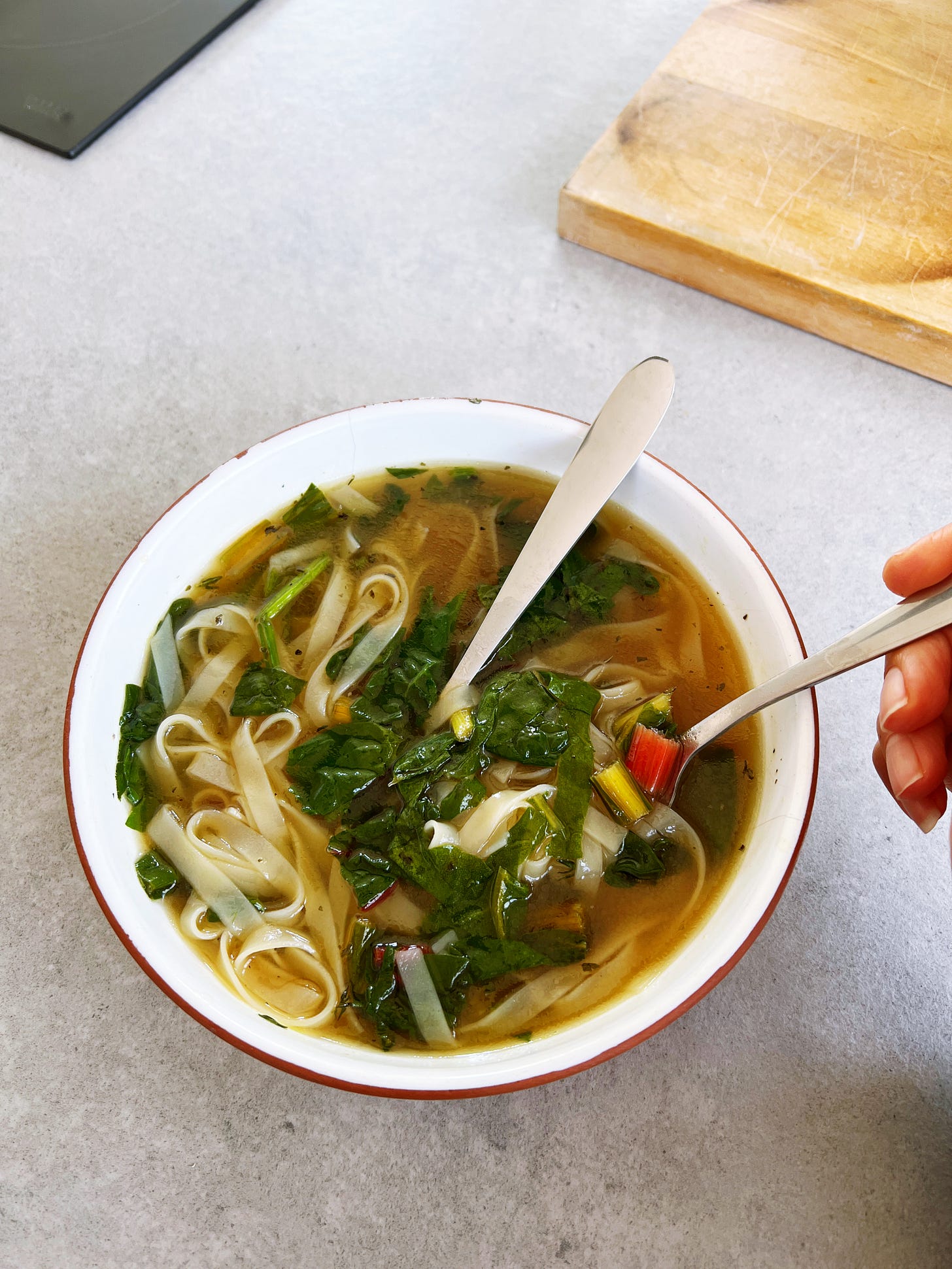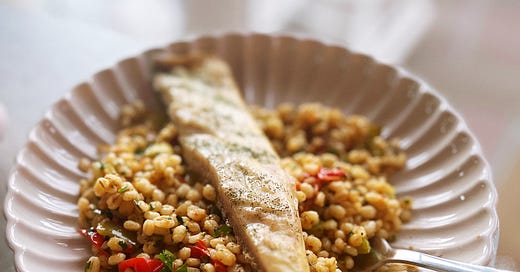The really big letter on food – from Ultra Processed to super-simple, here's my takeout
After an imbalanced week + UPF family 'review' at home – I'm nourishing with simple foods + deep-diving into my changing, perimenopausal body's needs
Firstly – this is an EPIC letter. If you haven’t already got a cuppa in hand, I’d suggest popping the kettle on ☺️
I am aware that all of my letters err on the long side. I even polled readers a few weeks ago, to ask if they were too long (at that point, 100% said they were ‘just right’ (phew).
Well, this one goes the extra mile for a reason – because it’s packed with the helpful, golden kernels of research re the common sense foundations for a realistic, practical + healthy approach to family food, that I’ve spent the last month working on.
Yes, this week’s Hot Buttered Toast really celebrates real(istic) + wholistic nourishment.
What MOTHER NOURISH is all about.
It’s a much deeper dive into food ‘specifics’ than I’d normally take, but that’s because I’ve spent the last month researching Ultra Processed Foods for my day job.
It’s also because I’m acutely aware that cooking from scratch is not always possible when you work full-time, write ‘on the side’, and have two kids, a dog, and a home to look after.
But I’ve also seen at first hand – from my kids’ babyhoods, and now up into their teen years – the impact that too much processed + sugary food can have on our children’s wondrous, growing bodies/minds, and our own.
And I’ve also had to accept that my food choices have an unusually strong effect on my body. I said to Mr R yesterday, that some people are like Teflon – nothing seems to ‘stick to’ or affect them. They can drink or eat anything, and their skin and bodies function with minimal disruption or effect.
I am the opposite. I am one of those atopic, highly sensitive types who is lactose-intolerant, had asthma as a kid, and still gets eczema and hay fever at times – particularly when I am run down, overly stressed, or my body has encountered something else it can’t cope with.
I am sensitive to washing up + laundry products, cosmetics, fragrances, dust mites, down + feathers… and while my sensitivity has lessened over time, mostly in line with my lower toxic and inflammatory load (including mitigating stress, getting better sleep, finding safer, natural home + health + beauty products), if I have had a particularly rough or heavy month (or been lax in my food + health choices), my sensitivity to any of the above will sometimes increase, almost overnight.
Alcohol (particularly port or red wine), vinegary, salty, spicy – these foods + flavour profiles so easily tip me into imbalance, too.
It’s the salty, sour and pungent (spicy) tastes in Ayurveda that aggravate and imbalance pitta (hot + fiery constitutions), so that’s no surprise to me. I am pitta, through-and-through. Alcohol is heating… think of how it subtly ‘burns’ the tongue, catches back of the throat and warms the insides on the way down.
I’ve had to recognise + accept that in summer and early autumn, the heat in my body is at its highest, and so I must be mindful of the pungent + salty foods I eat. But come later autumn and winter – when the weather cools + ‘brittles’ – the balance will shift and my body will feel cooler, drier – thereby needing more warmth, more unctuousness, more richness + oiliness, saltiness + sourness.
These seasonal recognitions and adaptations have helped me nourish myself with all there is to offer (the red wine awaits those crisp, cold, dragon-breath nights), at times when my body won’t be imbalanced by them, or most needs/craves them.
** If eating Ayurvedically + seasonally is of interest to you, I’d heartily recommend Geeta Vara’s brilliant, introductory book, and then Acharya Shunya’s book, for a deeper-dive into seasonal recipes, rituals, adjustments + holistic health. **
Rather than swear entire foods or groups off – or label anything ‘good’ or ‘bad’ – I prefer to think of how and what I eat as a tapestry of subtle choices.
But I do have a caveat. Because I’m increasingly drawing the line at ‘non-foods’. The sort of thing that will dye your tongue blue, has an ingredients list as long as your index finger, made up of dozens upon dozens of things you can’t pronounce or recognise.
Did you know that the average toddler’s diet is now made up of 47% Ultra Processed Foods (UPFs)?) And it’s 60% for adults. This is shocking, but perhaps not surprising.
As mentioned, I’ve spent weeks going through the latest study on UPFs published earlier this year by the British Medical Journal, which directly links a diet high in UPFs to 32 different, harmful health outcomes, including higher risk of heart disease, cancer, and type 2 diabetes.
The foods that result in the most harmful outcomes include processed meat products (this takes me back to Jamie’s school dinner war on ‘turkey twizzlers’, back in the day – almost 20 years ago – can you believe it’s been that long?). Alongside the very low quality of meat in the first place, there’s the reconstitution process, nitrates/nitrites, additives, bulking agents and binders needed to fashion the ‘meat’ into a ‘nugget’, or dinosaur or ‘twizzler’ (or whatever it may end up as).
UPFs with the higher markers for lower health outcomes also include energy + fizzy drinks (those with sugar and/or artificial sweeteners) and baked goods (particularly those with hydrogenated oils).
Having read the report, and then devoured Ultra Processed People by Chris Van Tulleken, I did have an overzealous moment of believing that I had to clear out every cupboard, ban my kids from eating anything in a packet, and committing to making every single thing we eat from scratch.
Then I woke up the next day and realised this would be impossible. I work full time. Mr R works late afternoons into evenings (his shift often taking him up to or beyond midnight).
When I get home from work, I am happy to cook, but I am also tired, the girls need a dozen things from me, the Pup needs a walk and feed, and the house probably has several ‘needs’ too (there’s always something to wash up and a load of washing to put away, put on and hang out again).
On nights like that, I will very likely make something super-simple.
IF there are no leftovers, I might:
pop some fish into foil, add herbs + lemon, then cook at 150 degrees in the oven for 20 mins, and serve on a bed of herby rice
or mix pasta with pesto (pre-made at home or shop-bought), frozen peas, parmesan
or add noodles + chicken + greens to some good stock (which we make once a week, and freeze for a speedy, nourishing base for midweek meals).

** pssst I’ll expand on these suggestions, and others, in my next FOOD letter to paid subscribers which features my Seven Speedy but Nourishing Family Dinner Ideas.**
But when it comes to UPFs, I also need to be honest with myself. I know the harm they cause. I know that too many of us eat too many of them. I know how ‘bleurgh’ I feel if I’ve had a week when I’ve had to grab ‘convenience’ food more often, or have relied on ready meals or takeaways (the latter presently limited to freshly-caught Brixham fish + chips from the Friday ‘pop up’ van in our village, because: no Deliveroo available here!).
I have always been a label-reader + questioner. That comes from 20 years as a wellness author + journalist. I can’t un-know what I know, and there are always things I avoid if I see them on a label.
I’ve found the Nova classification for foods quite helpful (mostly). It breaks all foods down into groups 1 to 4, with 1 being Unprocessed or Minimally Processed, and 4 being Ultra-Processed Food and Drink Products.
The rough breakdown is:
Group 1 (Unprocessed or Minimally Processed Foods) include
Fresh, squeezed, chilled, frozen, or dried fruits and leafy and root vegetables
Grains such as brown, parboiled or white rice, corn cob or kernel, wheat berry or grain
Legumes such as beans of all types, lentils, chickpeas
Starchy roots and tubers such as potatoes, in bulk or packaged
Fungi such as fresh or dried mushrooms
Meat, poultry, fish and seafood, whole or in the form of steaks, fillets and other cuts, or chilled or frozen
Eggs
Milk
Fresh or pasteurised fruit or vegetable juices without added sugar, sweeteners or flavours
Grits, flakes or flour made from corn, wheat, oats, or cassava; pasta, couscous and polenta made with flours, flakes or grits and water
Tree and ground nuts and other oil seeds without added salt or sugar
Spices such as pepper, cloves and cinnamon; and herbs such as thyme and mint, fresh or dried
Plain yoghurt with no added sugar or artificial sweeteners added
Tea, coffee, water
Group 2 (Processed Culinary Ingredients) include:
These are substances obtained directly from group 1 foods or from nature by processes such as pressing, refining, grinding, milling, and spray drying.
The purpose of processing here is to make products used in home and restaurant kitchens to prepare, season and cook group 1 foods and to make with them varied and enjoyable hand-made dishes, soups and broths, breads, preserves, salads, drinks, desserts and other culinary preparations.
Group 2 items are rarely consumed in the absence of group 1 foods. Examples are:
Salt mined or from seawater
Sugar and molasses obtained from cane or beet
Honey extracted from combs and syrup from maple trees
Vegetable oils crushed from olives or seeds
Butter and lard obtained from milk and pork
Starches extracted from corn and other plants.
Group 3 (Processed Foods) include:
These are relatively simple products made by adding sugar, oil, salt or other group 2 substances to group 1 foods.
Most processed foods have two or three ingredients.
Processes include various preservation or cooking methods, and, in the case of breads and cheese, non-alcoholic fermentation.
Canned or bottled vegetables, fruits and legumes
Salted or sugared nuts and seeds
Salted, cured, or smoked meats
Canned fish
Fruits in syrup
Cheeses and unpackaged freshly made breads
Processed foods may contain additives used to preserve their original properties or to resist microbial contamination. Examples are fruits in syrup with added anti-oxidants, and dried salted meats with added preservatives.
When alcoholic drinks are identified as foods, those produced by fermentation of group 1 foods such as beer, cider and wine, are classified here in Group 3.
Group 4 (Ultra Processed Foods) include:
These are industrial formulations typically with five or more and usually many ingredients. Such ingredients often include those also used in processed foods, such as sugar, oils, fats, salt, anti-oxidants, stabilisers, and preservatives.
These are - in short – the sort of ingredients you wouldn't find in a home kitchen.
Substances only found in ultra-processed products include some directly extracted from foods, such as casein, lactose, whey, and gluten, and some derived from further processing of food constituents, such as hydrogenated or interesterified oils, hydrolysed proteins, soy protein isolate, maltodextrin, invert sugar and high fructose corn syrup.
Classes of additive only found in ultra-processed products include:
Dyes and other colours and colour stabilisers
Flavours + flavour enhancers
Non-sugar sweeteners
Processing aids such as carbonating, firming, bulking and anti-bulking, de-foaming, anti-caking and glazing agents, emulsifiers, sequestrants and humectants.
Several industrial processes with no domestic equivalents are used in the manufacture of ultra-processed products, such as extrusion and moulding, and pre-processing for frying.
Examples of typical ultra-processed products are:
Carbonated drinks
Sweet or savoury packaged snacks
Commercially-made ice-cream, chocolate, candies (confectionery)
Mass-produced packaged breads and buns
Margarines and spreads
Cookies + biscuits
Pastries, cakes, and cake mixes
Most breakfast cereals
Energy drinks
Milk drinks, ‘fruit’ yoghurts and ‘fruit’ drinks (not pure fruit juice, or natural yoghurt)
Meat and chicken extracts and ‘instant’ sauces
‘Health’ and ‘slimming’ products such as powdered or ‘fortified’ meal and dish substitutes
Many ready to heat products including pre-prepared pies and pasta and pizza dishes
Poultry and fish ‘nuggets’ and ‘fish sticks’, sausages, burgers, hot dogs, and other reconstituted meat products
Powdered and packaged ‘instant’ soups, noodles and desserts.
Based on the above, I have tried to work out a simple, common-sense list of the things I don’t really want to eat or feed my family.
These include:
Energy + fizzy drinks. We don’t buy them or have them at home, but are fully aware that our kids may order them when out with friends 😢 .
I also prefer food or drink sweetened with natural sugar over artificial sweeteners such as aspartame (also known as E951) or acelsulfame-k (also known as Ace-k, Sunett + Sweet One, or E950), due to their potential ability to disrupt metabolism and gut hormones. Purely anecdotally, I can always taste sweeteners in food… they taste synthetic + unpleasant to my palate. Though studies are yet to unanimously conclude on their health effects, I prefer to avoid.
As a side note, we try to sweeten the things we bake at home with unrefined sugars, such as unrefined cane sugar, muscovado, jaggery, unrefined date sugar, rapadura, honey or maple syrup. We don’t bake with honey (Ayurveda doesn’t advise heating honey, and as we buy raw honey for all of its natural goodness, it’s counterintuitive anyway), but we do use honey to sweeten things like pancakes, once served.Reconstituted meat products. We used to buy nuggets or arbitrarily posher ‘goujons’ 😆 a couple of times a month, for easy-peasy dinners, or when the kids had friends over (fussy eaters always seem to request chicken nuggets?).
Since reading the BMJ report, we’ve pretty much phased them out… Mr R, on a day off, might butterfly two chicken breasts, or dice some thigh meat, and then bread + herb/salt the chicken himself. ‘Chicken parmigiana’ often replaces the nuggets, but because we buy organic meat, we can only afford to serve it once a week (better quality meat is far more expensive and there’s no getting around it).Commercial breakfast cereals. Most of these are highly processed (😢). I am, however, partial to a bowl of cereal with cold milk, and have moved over from more processed cereals to Bio&Me granola, whose ingredients make sense (no added salt, sugar and they’re baked at a low heat using extra virgin olive oil) and support gut health with prebiotics + fibre (nope, as ever, not an ad). Also determined to get back into the habit of making my own granola, as it always tastes better anyway!
Hydrogenated fats, hydrogenated oils, margarine or any product that contains ‘trans fats’. Trans fats are so-called because an oil is transformed into a more solid ‘fat’, using a variety of processes. The World Health Organisation found that ‘high intake of trans fat increases the risk of death from any cause by 34%, coronary heart disease deaths by 28%, and coronary heart disease by 21%. Trans fat has no known health benefits.’
They are not banned in the UK, but public pressure has led many manufacturers to remove them. Legally you don’t have to label ‘trans fats,’ but you do have to label hydrogenated fats/oils – so check those labels.Invert/ed sugar syrups. Invert sugars are created by mixing sucrose with water, and heating to high temperatures to break the bonds between the glucose + fructose. They are lower in calories than regular sugar, but have a higher glycemic index than regular sugar and so have been linked to insulin resistance and high blood sugar, both of which can lead to Type 2 Diabetes. As my paternal grandmother is diabetic, I am mindful of anything that causes these unnatural spikes.
Carrageenan (after multiple studies have linked it to digestive problems, this commonly used thickener is one I avoid). Often found in vegan ‘milks’ – we get ours from ReRooted (via our Riverford delivery), because they don’t put anything funky in their formulas. IF I could tolerate cow’s milk, I’d order organic milk from here.
MSG (used for a deeply ‘umami’ flavour). Monosodium Glutamate used to be used in crispy seaweed a lot, in Chinese restaurants. As a kid, every time I ate crispy seaweed (once a month, if we had a takeaway), I would start scratching like mad and often get an eczema flare-up. For that reason, I personally avoid it – it seems, somehow, to trigger skin sensitivity reactions for me. Other anecdotal evidence has linked MSG consumption to headaches. There have been lots of additional studies into MSG, but they’re all contradictory – i.e. the jury’s still out on the health effects, but I’d pay attention to your own body.
Carboxymethylcellulose and Polysorbate-80 (both emulsifiers commonly found in processed bread) – linked to gut inflammation + impaired gut microbiota.
Nitrates (commonly labelled as E numbers E249 to E252; often found in meat, processed + non; most commonly, sausages + bacon, to keep their ‘pink’ colour, add flavour + prevent growth of bacteria). Not the same as natural dietary nitrates, found in veggies, such as kale, spinach, beetroot, celery.
** As an additional aside, I pay absolutely NO attention whatsoever to an unprocessed or minimally processed food’s calorie content. Food that is high in good, natural fats – from nuts + nut butters, to seeds + seed butters, to oily fish and grass-fed butter, to olive oil and avocados, to whole milk + whole yoghurt, to coconut milk, cream + oil, eggs with their yolks, to pretty much all cheese – are all comparatively high/er in calories. **
But they are also whole, satiating, nourishing foods. We eat less of them because they’re so filling + nutrient-dense. We stay fuller for longer. They are delicious + nutritious + unprocessed. Win Win Win.
Many of these foods are also high in essential omega fatty acids, vitamins, minerals, protein + those ‘good fats’, which help us maintain healthy cholesterol levels in the first place.
As women, we also NEED MORE FAT. In the most basic nutshell, we need to consume healthy fats in order to produce healthy hormones – which are made up of both fats + proteins.
I’d also just gently caveat coconut oil, which is 80-92% saturated fat, but also high in lauric acid – so you do get heart health benefits with it, but don’t want to eat mad amounts of it either. This is something I’ve changed my view on since cutting out dairy a few years ago, and (at the time) relying more on coconut-oil based vegan cheese substitutes. I still have coconut oil as it’s intended to be used – as a cooking oil (if we’re making curry, or vegan pancakes) – but not as something I eat in larger quantities.
After some blood tests last year, I also decided to return to eating fish, small amounts of meat, and dairy (favouring sheep + goat cheeses, such as feta + halloumi), and stopped eating coconut-oil-based cheeses. I do, however, love a few different nut-based vegan cheeses, such as this particularly good one from Riverford.
p.s. Fancy £15 off a Riverford Organic Box? You can use my Refer a Friend code 🥰
https://www.riverford.co.uk/refer/f-biqdZHTcnShGAUVRjjgw
Though this is by no means an exhaustive list, I’ve kept it above the pay wall, in the hopes that it may prove helpful. Please do share if you know of anyone who’d be interested in reading the above.
As for me, what do I do about the processed food we still buy + enjoy as a family (Cakes? Crisps? Croissants?).
It’s an ever-evolving journey, but this is where I’m at, right now… scroll down to get ideas re the easier ways I’ve found to nourish myself + my family a little better this week, and your 7 Daily Doses of Nourishment for the week ahead.
Thank you for being here,
Emine
Keep reading with a 7-day free trial
Subscribe to MOTHER NOURISH with Emine Rushton to keep reading this post and get 7 days of free access to the full post archives.






